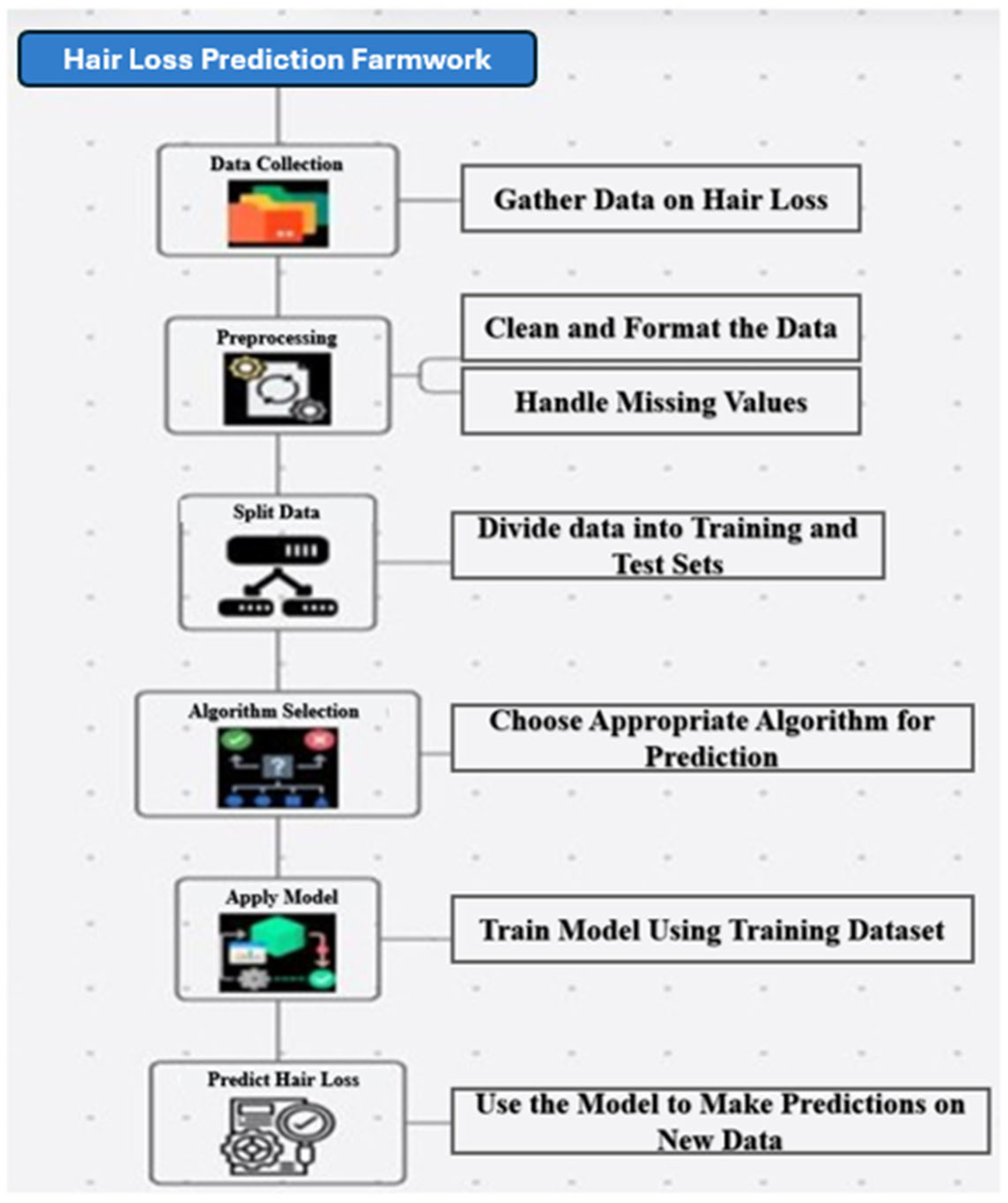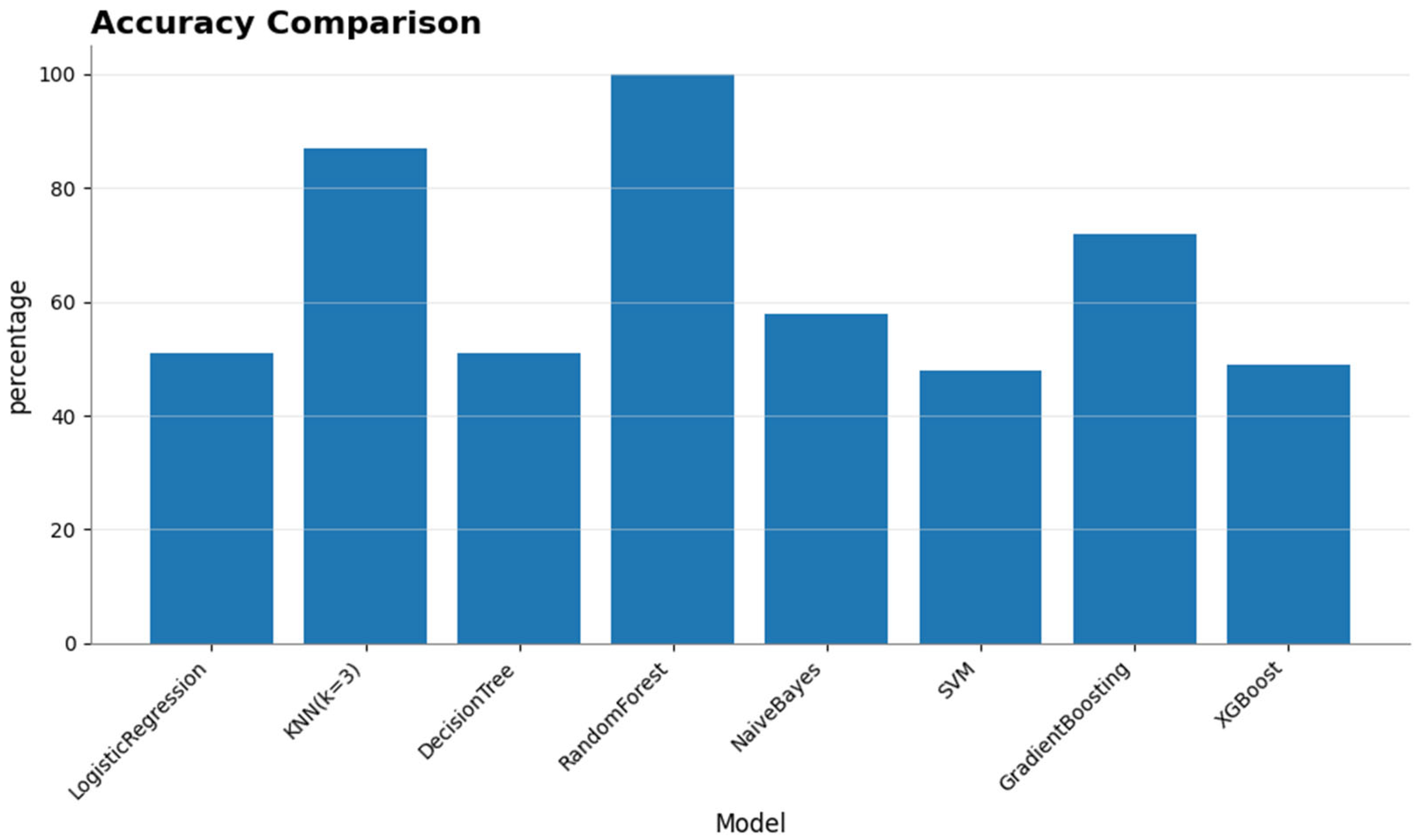An Early Hair Loss Detection and Prediction Method Based on Machine Learning †
Abstract
1. Introduction
2. Literature Review
3. Methodology
3.1. Data Collection and Preprocessing
3.2. Data Partitioning
3.3. Model Development
- Logistic Regression: This algorithm served as the baseline model, establishing the standard for the performance of the other models. It is also suitable for tasks that involve binary classification only.
- KNN: This technique was explored with various values of k (3) to determine the optimal number of nearest neighbors for classifying the data points. KNN is a non-parametric method that can adapt well to different data distributions.
- Random Forest: This ensemble learning method was fine-tuned using GridSearchCV, which systematically searches through multiple combinations of hyperparameters to find the best configuration for improved accuracy and performance.
- Gradient Boosting and XGBoost: These advanced algorithms were applied to effectively capture and model complex relationships within the data, enhancing predictive performance by sequentially addressing the errors of previous models.
4. Results and Discussion
4.1. Model Performance
4.2. Feature Importance
5. Conclusions
Future Enhancements
- Growing Datasets:
- By broadening our datasets to incorporate a more diverse statistical run, we point to a way to better obtain the components affecting hair loss over different populations.
- Tending to Course Awkwardness:
- We will execute progressive procedures such as oversampling, undersampling, or algorithmic alterations to upgrade the model’s vigor and exactness, especially for underrepresented groups.
- Moving Forward and Demonstrating Execution:
- Our future work will investigate hyperparameter tuning and highlight choices to advance and refine the model’s prescient capabilities and decrease mistakes.
- The suggestions of our discoveries expand to progressing the field of trichology and moving forward quiet care. By giving exact, data-driven forecasts, this investigation lays the basis for more solid demonstrative instruments, which may help healthcare experts in making educated choices. Whereas this study centers exclusively on demonstrating improvement, future integration with viable symptomatic workflows has the potential to revolutionize hair loss administration.
Author Contributions
Funding
Institutional Review Board Statement
Informed Consent Statement
Data Availability Statement
Conflicts of Interest
References
- Roy, M.; Protity, A.T. Hair and scalp disease detection using machine learning and image processing. Eur. J. Inf. Technol. Comput. Sci. 2023, 47, 1–10. Available online: https://www.ej-compute.org/index.php/compute/article/view/85 (accessed on 25 June 2025).
- Zhang, L.; Man, Q.; Cho, Y.I. Deep-learning-based hair damage diagnosis method applying scanning electron microscopy images. Diagnostics 2021, 11, 1831. [Google Scholar] [PubMed]
- Kim, J.-H.; Lee, S.-H.; Moon, Y.-S. Hair follicle classification and hair loss severity estimation using Mask R-CNN. J. Imaging 2022, 8, 283. [Google Scholar] [CrossRef] [PubMed]
- Kim, H. Development of scalp diagnosis algorithm using surface-sensing convolutional neural network. Natl. Acad. Sci. Lett. 2024, 47, 1–5. Available online: https://www.researchgate.net/publication/371862840 (accessed on 25 June 2025). [CrossRef]
- Gupta, M.; Mysore, V. Classifications of patterned hair loss: A review. J. Cutan. Aesthetic Surg. 2016, 9, 3–12. [Google Scholar] [CrossRef] [PubMed]
- Kim, M.; Kang, S.; Lee, B.D. Evaluation of automated measurement of hair density using deep neural networks. Sensors. 2022, 22, 650. [Google Scholar] [CrossRef] [PubMed]
- Kim, M.; Gil, Y.; Kim, Y.; Kim, J. Deep-learning-based scalp image analysis using limited data. Electronics. 2023, 12, 1380. [Google Scholar] [CrossRef]
- Sayyad, S.; Midhunchakkaravarthy, D. Deep review on alopecia areata diagnosis for hair loss-related autoimmune disorder problem. Int. J. Health Sci. 2022, 6, 123–130. Available online: https://journals.innovareacademics.in/index.php/ijap/article/view/45533/26767 (accessed on 25 June 2025). [CrossRef]
- Kumar, G.R.; Banerjee, D. CNN-KNN Model for Assessing Hair Health in Telogen Effluvium. In Proceedings of the IEEE 2025 3rd International Conference on Intelligent Data Communication Technologies and Internet of Things (IDCIoT), Bengaluru, India, 5–7 February 2025; pp. 1531–1537. [Google Scholar]
- Karo, I.M.K.; Kiswanto, D.; Panggabean, S.; Perdana, A. Hair Disease Classification Using Convolutional Neural Network (CNN) Algorithm with VGG-16 Architecture. Sink. J. Dan Penelit. Tek. Inform. 2023, 7, 2786–2793. [Google Scholar] [CrossRef]
- Krishnamoorthy, N.; Jayanthi, P.; Kumaravel, T.; Sundareshwar, V.A.; Harris, R.S.J. Scalp disease analysis using deep learning models. Appl. Comput. Eng. 2023, 2, 1003–1009. [Google Scholar] [CrossRef]
- Saraswathi, C.; Pushpa, B. Ab-mtedeep classifier trained with aagan for the identification and classification of alopecia areata. Eng. Technol. Appl. Sci. Res. 2023, 13, 10895–10900. [Google Scholar] [CrossRef]
- Sai, C.N.V.; Archana, E.; Vivek, B.; Dhanwanth, B.; Viknesh, K.S. Enhancing Hairfall Prediction: A Comparative Analysis of Individual Algorithms and An Ensemble Method. Int. J. Recent Innov. Trends Comput. Commun. 2023, 11, 499–508. [Google Scholar] [CrossRef]
- Babbar, H.; Rani, S.; Masud, M.; Verma, S.; Anand, D.; Jhanjhi, N. Load balancing algorithm for migrating switches in software-defined vehicular networks. Comput. Mater. Continua 2021, 67, 1301–1316. [Google Scholar] [CrossRef]
- Kok, S.H.; Azween, A.; Jhanjhi, N.Z. Evaluation metric for crypto-ransomware detection using machine learning. J. Inf. Secur. Appl. 2020, 55, 102646. [Google Scholar] [CrossRef]
- Alshudukhi, K.S.S.; Ashfaq, F.; Jhanjhi, N.Z.; Humayun, M. Blockchain-enabled federated learning for longitudinal emergency care. IEEE Access 2024, 12, 137284–137294. [Google Scholar] [CrossRef]



| Ref | Year | ML Algorithms | Performance |
|---|---|---|---|
| [1] | 2023 | CNN, Random Forest | High accuracy, sensitivity, and specificity |
| [2] | 2021 | Deep learning | 94.8% accuracy |
| [3] | 2022 | ResNet, Mask R-CNN | 4–15% increase in classification accuracy |
| [4] | 2021 | CNN, CBAM, DSC, FC | 85.03% accuracy |
| [5] | 2022 | YOLOv4, DetectoRS, EfficientDet | YOLOv4: 58.67 mean average precision |
| [6] | 2023 | ResNet, ResNeXt, DenseNet, XceptionNet | 95.75% accuracy, 87.05 F1 score |
| [7] | 2022 | ANNs, CLAHE, VGG, CNN, SVM | Improved accuracy in classifying healthy and alopecia cases |
| [8] | 2023 | ANNs, CLAHE, VGG, CNN, SVM | Enhanced precision in classification |
| [9] | 2023 | CNN, VGG-16 | 94.5% accuracy |
| [10] | 2023 | CNN, VGG16, VGG19, MobileNetV2 | High accuracy in disease prediction |
| [11] | 2023 | YOLOv5 | mAP of 0.8151, optimal results with YOLOv5l in multiclass detection |
| [12] | 2024 | CNN | 98.78% accuracy |
| [13] | 2023 | AB-MTEDeep, FRCNN, LSTM, AA-GAN | 96.94% accuracy |
| [14] | 2023 | CNN, Random Forest | High accuracy, sensitivity, and specificity |
| [15] | 2023 | CNN, Random Forest, SVM, KNN | Improved accuracy, precision, and recall |
| Model | Accuracy |
|---|---|
| Logistic Regression | 51.25% |
| KNN (k = 3) | 87.09% |
| Decision Tree | 51.65% |
| Random Forest | 99.80% |
| Naive Bayes | 58.16% |
| SVM | 49.33% |
| Gradient Boosting | 71.77% |
| XGBoost | 49.33% |
| True No | True Yes | Class Precision | |
|---|---|---|---|
| pred. No | 500 | 0 | 100.00% |
| pred. Yes | 2 | 497 | 99.60% |
| class recall | 99.60% | 100.00% |
Disclaimer/Publisher’s Note: The statements, opinions and data contained in all publications are solely those of the individual author(s) and contributor(s) and not of MDPI and/or the editor(s). MDPI and/or the editor(s) disclaim responsibility for any injury to people or property resulting from any ideas, methods, instructions or products referred to in the content. |
© 2025 by the authors. Licensee MDPI, Basel, Switzerland. This article is an open access article distributed under the terms and conditions of the Creative Commons Attribution (CC BY) license (https://creativecommons.org/licenses/by/4.0/).
Share and Cite
Ahmad, M.; Mir, A.; Permana, A. An Early Hair Loss Detection and Prediction Method Based on Machine Learning. Eng. Proc. 2025, 107, 126. https://doi.org/10.3390/engproc2025107126
Ahmad M, Mir A, Permana A. An Early Hair Loss Detection and Prediction Method Based on Machine Learning. Engineering Proceedings. 2025; 107(1):126. https://doi.org/10.3390/engproc2025107126
Chicago/Turabian StyleAhmad, Muhammad, Azka Mir, and Anton Permana. 2025. "An Early Hair Loss Detection and Prediction Method Based on Machine Learning" Engineering Proceedings 107, no. 1: 126. https://doi.org/10.3390/engproc2025107126
APA StyleAhmad, M., Mir, A., & Permana, A. (2025). An Early Hair Loss Detection and Prediction Method Based on Machine Learning. Engineering Proceedings, 107(1), 126. https://doi.org/10.3390/engproc2025107126





